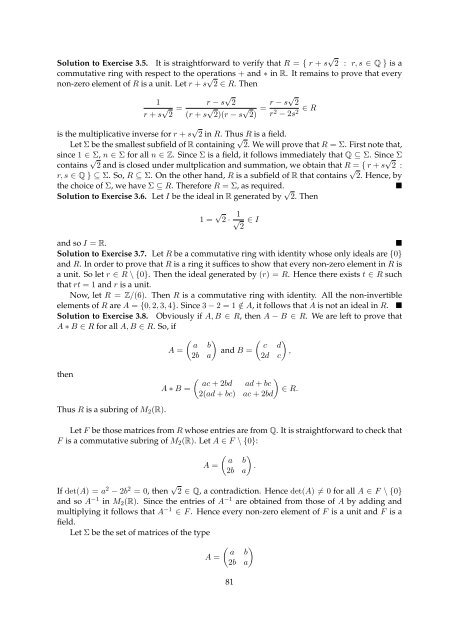School of Mathematics and Statistics MT4517 Rings & Fields ...
School of Mathematics and Statistics MT4517 Rings & Fields ...
School of Mathematics and Statistics MT4517 Rings & Fields ...
Create successful ePaper yourself
Turn your PDF publications into a flip-book with our unique Google optimized e-Paper software.
Solution to Exercise 3.5. It is straightforward to verify that R = { r + s √ 2 : r, s ∈ Q } is a<br />
commutative ring with respect to the operations + <strong>and</strong> ∗ in R. It remains to prove that every<br />
non-zero element <strong>of</strong> R is a unit. Let r + s √ 2 ∈ R. Then<br />
1<br />
r + s √ 2 = r − s √ 2<br />
(r + s √ 2)(r − s √ 2) = r − s√ 2<br />
r 2 − 2s 2 ∈ R<br />
is the multiplicative inverse for r + s √ 2 in R. Thus R is a field.<br />
Let Σ be the smallest subfield <strong>of</strong> R containing √ 2. We will prove that R = Σ. First note that,<br />
since 1 ∈ Σ, n ∈ Σ for all n ∈ Z. Since Σ is a field, it follows immediately that Q ⊆ Σ. Since Σ<br />
contains √ 2 <strong>and</strong> is closed under multplication <strong>and</strong> summation, we obtain that R = { r + s √ 2 :<br />
r, s ∈ Q } ⊆ Σ. So, R ⊆ Σ. On the other h<strong>and</strong>, R is a subfield <strong>of</strong> R that contains √ 2. Hence, by<br />
the choice <strong>of</strong> Σ, we have Σ ⊆ R. Therefore R = Σ, as required.<br />
<br />
Solution to Exercise 3.6. Let I be the ideal in R generated by √ 2. Then<br />
1 = √ 2 ·<br />
1<br />
√<br />
2<br />
∈ I<br />
<strong>and</strong> so I = R.<br />
<br />
Solution to Exercise 3.7. Let R be a commutative ring with identity whose only ideals are {0}<br />
<strong>and</strong> R. In order to prove that R is a ring it suffices to show that every non-zero element in R is<br />
a unit. So let r ∈ R \ {0}. Then the ideal generated by (r) = R. Hence there exists t ∈ R such<br />
that rt = 1 <strong>and</strong> r is a unit.<br />
Now, let R = Z/(6). Then R is a commutative ring with identity. All the non-invertible<br />
elements <strong>of</strong> R are A = {0, 2, 3, 4}. Since 3 − 2 = 1 /∈ A, it follows that A is not an ideal in R. <br />
Solution to Exercise 3.8. Obviously if A, B ∈ R, then A − B ∈ R. We are left to prove that<br />
A ∗ B ∈ R for all A, B ∈ R. So, if<br />
( ) ( )<br />
a b<br />
c d<br />
A = <strong>and</strong> B = ,<br />
2b a<br />
2d c<br />
then<br />
( )<br />
ac + 2bd ad + bc<br />
A ∗ B =<br />
∈ R.<br />
2(ad + bc) ac + 2bd<br />
Thus R is a subring <strong>of</strong> M 2 (R).<br />
Let F be those matrices from R whose entries are from Q. It is straightforward to check that<br />
F is a commutative subring <strong>of</strong> M 2 (R). Let A ∈ F \ {0}:<br />
( ) a b<br />
A = .<br />
2b a<br />
If det(A) = a 2 − 2b 2 = 0, then √ 2 ∈ Q, a contradiction. Hence det(A) ≠ 0 for all A ∈ F \ {0}<br />
<strong>and</strong> so A −1 in M 2 (R). Since the entries <strong>of</strong> A −1 are obtained from those <strong>of</strong> A by adding <strong>and</strong><br />
multiplying it follows that A −1 ∈ F . Hence every non-zero element <strong>of</strong> F is a unit <strong>and</strong> F is a<br />
field.<br />
Let Σ be the set <strong>of</strong> matrices <strong>of</strong> the type<br />
( ) a b<br />
A =<br />
2b a<br />
81













